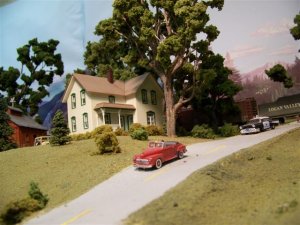When doing scenery, look at all the bushes and shrubs around your own local as often there are dead twigs that either fall of or can be broken off which make nice armatures for trees or as Montanan above said branches of Sage Brush, Oak and others make great trees for for your layout and with either the Oak or Sagebrush the natural bark can't be beat.
Also I've taken smaller sticks of Oak and cut them to length and then split them with an xacto knife and if they don't cut perfectly that added detail at no cost as the real Oak doesn't split perfectly smooth either so enjoy the effect as it as natural as it gets. Also another nice feature of using Oak sticks or others is that you not only get the natural bark but the small growth rings in the wood.
In fact I had Woodland Scenics wondering how I managed to model such great look cord wood, stacked Oak cord wood, till I told the lady there it was real Oak sticks cut and split and she said no wonder.
So remember, you just can't beat the real thing when it comes to realism.
Don't forget to stop at a garden or landscape center where they sell bulk supplies of Redwood bark and other items as they generally have a lot of excess scattered in front of the various piles that they probably just give you as it pretty fine but works just fine for our N, HO, S & O gauge layouts.
As far as dirt again it's readly available at either the landscape center or a field or lot near you or even along the edges of roads where there is a cut as there is most always loose dirt that piles up along the roadway or enough loose dirt in the bank to be had. If it should contain small rocks there is added detail once sifted out. Don't forget to use different fineness of screens such as tea streigners and flower streigners to get different coarseness of dirt and even small rocks.
Sift the dirt etc onto a couple of thicknesses of news paper at the fold area so once done you can easily let your effort slide off into any type of container such as an empty flavored coffee creme container, so it can be easily sprinkled on later or transferred to a container with a number of holes in the top as like seasoning bottles etc.
Also don't overlook dirt that has some different coloration to it as that all ads realism to your layout.
Need some straw to place in and around a farm scene or in cattle cars find a field with the golden oats pick or cut a bunch of the stuff as it crumbles when rubbed between your fingers or hands and make great natural looking straw because it is!
If you have any Ornimental Bamboo/Nandenia bushes, once they flower the stem of the blossoms with all it's little branches dies on the bush and make great looking small trees with some Woodland Scenics lace material added along with some ground foam of your choice.
Another tip is to use Woodland Scenics Hobby tack to place objects to check out the effect. As a suggestion, cut the clear acitate from plastic containers from the bakery section into small 1"x1" squares to hold the armatures of small trees with the Hobby tack after it dry in an upright position so you can get a feel of how you want them arranged on your layout. On hill sides, if the surface is free of loose material the hobby tack with also aid in the placement so you can step back and see if the effect is what you wanted.
If you want to easily make some rock molds get a quart can of liquid latex and once you've found a rock/s you want to make a mold of a portion of it, clean off any loose stuff first and paint that area with the liquid latex being certain to push the bristles into all the cracks and crevices and let it dry and then give it another coat and and let it dry then you can peal the mold off the rock and have a mold to work with. Remember most molds need to lay fairly flat to begin with to allow you to pour the Hydrocal into them so take that into account when making your molds. By not making the molds to thick or stiff it will allow you to let your casting conform to the terrain of your hillside or cliff. Just wait till the Hydrocal is about 80% dry and pre-wet the area with water that has a couple of drops of dish soap added as a wetting agent.
Oh, if you want some great looking HO scale Redwood logs find a bottle brush bush, and if there are any branches that are trimmed off you'll probably have some to use. The Counties often use these bushes for ornamentials shrubs and generally having trimmings.
Hth.


